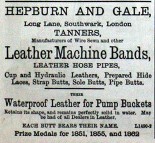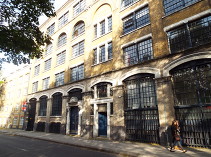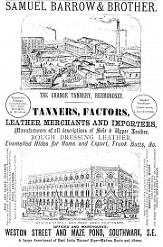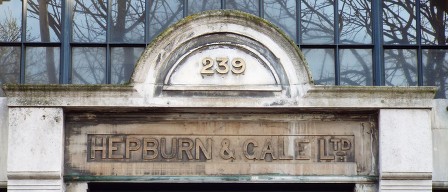





Exploring Southwark and discovering its history
- Home
- About
- Bankside
- Bermondsey
- Bermondsey Industry
- Borough
- Camberwell
- Dulwich
- Newington & Walworth
- Peckham & Nunhead
- Rotherhithe
- Southwark Streets
- Lost Southwark
- Search
- Contact
- Non Gamstop Casinos
- Non Gamstop Casinos
- Non Gamstop Casinos
- Casinos Not On Gamstop
- Non Gamstop Casinos


Barrow, Hepburn and Gale
Barrow, Hepburn and Gale was perhaps the largest leather concern in Bermondsey in the 20th century formed by mergers and amalgamations with other Bermondsey tanners and leather manufacturers, some of which went back to the middle of the 18th century. The most prominent reminder today of this once thriving company are former warehouses, now an apartment complex that goes by the name Tanners Yard, at 239 Long Lane with a stone plaque bearing the inscription Hepburn and Gale over the entrance.

Hepburn and Gale was started by John Hepburn who moved to Bermondsey in the 1770s from Chesham in Buckinghamshire where his father owned a tanning yard. John Hepburn purchased three tanneries in Long Lane that had been in existence since the middle of the 17th century. Two of John’s seven sons, John and Thomas, became involved in the company now called Hepburn and Sons.
Edward Brayley gives a description of the business in the Appendix to his Topographical History of Surrey published in 1841. Two further tanneries had been absorbed into the two and a half acre site on Long Lane which was covered partly in buildings and partly in numerous tan pits. From his viewpoint in the Leather Market, Brayley admired the lofty and elegant chimney rising 175 feet high from the Hepburn tannery which he described as one of the “largest and most complete private establishments of the kind in the world.” The tannery had embraced mechanisation with a 20 horse power engine and other machines and employed 250 workers.
After the deaths of John and Thomas Hepburn, the company ran into financial difficulties in the 1880s. A partnership was formed with a family member, Frederick Gale, who discharged the liabilities of Hepburn and Son. The company continued trading as Hepburn and Gale. The advert to the right points to the production heavy leather and the manufacture of industrial products.
Disaster struck in 1898 when the Long Lane premises were engulfed by a fire that had started early one morning and spread rapidly. The fire report stated that a range of buildings, measuring approximately 160ft x 90ft and six storeys high which had been in use as an engine and boiler house, manufactory and stores were burnt and partly fallen down, and a smaller six-storey building used as office, stores and dwelling had suffered damage to the top three floors.

The present building dates from after the fire
In 1901 Hepburn and Gale moved to premises in Grange Road and two years later merged with Ross & Co to form Hepburn, Gale and Ross.
Ross and Co dated back to at least the 18th century and were manufacturers of leather goods made from finished leather bought from local tanneries. They supplied leather equipment to various departments of the Government including the War Office and Admiralty, supplying saddlery and other equestrian related goods. By 1895 they had become the largest contractor of leather goods for the British Army and a major supplier of military equipment in the First World War.
In 1920 Hepburn Gale and Ross merged with Samuel Barrow and Brother to form Barrow, Hepburn and Gale, an incorporated public Company.
Barrow Hepburn and Gale acquired further companies, some outside of London, in the first half of the 20th Century and by 1948 their factories covered an area of over 1000 acres, employed 2,500 skilled workpeople and had an annual turnover of £6 million. Among the goods they manufactured were trunks, suitcases, attaché, cases, document cases, school, cricket, golf, tennis, cash and cycle bags, rucksacks and holdalls, straps, industrial gloves and aprons. They also made the ministerial dispatch cases.

Samuel Barrow had worked alongside his father in the tanning yard of Elias Tremlett until 1848 when the tanning works closed. Undaunted, Samuel decided to start his own yard and John Barrow and Sons was formed and conducted business from premises in Wild’s Rents. Later the firm was called Samuel Barrow and Brother, the brother was Reuben Vincent Barrow who was at one time the MP for Bermondsey. By 1900 the company owned four tanneries in The Grange, Grange Road, Spa Road and one in Redhill, and warehouses in Weston Street, Maze Pond and St Thomas’ Street.
The end of the once thriving industry ended very abruptly. After the second world war there was increasing competition from cheaper leather from overseas and, as products formerly made from leather became increasingly available manufactured from synthetics, demand for leather goods fell. Able to trace a heritage back over 200 years, Barrow Hepburn and Gale closed their operations in Bermondsey in the 1970s.
The brand of Barrow Hepburn and Gale still survives and holds royal warrants for the supply and repair of ministerial dispatch cases and the manufacture of purses for the distribution of Maundy Money. They also restore historical items made from leather.

© www.exploringsouthwark.co.uk 2014-2019